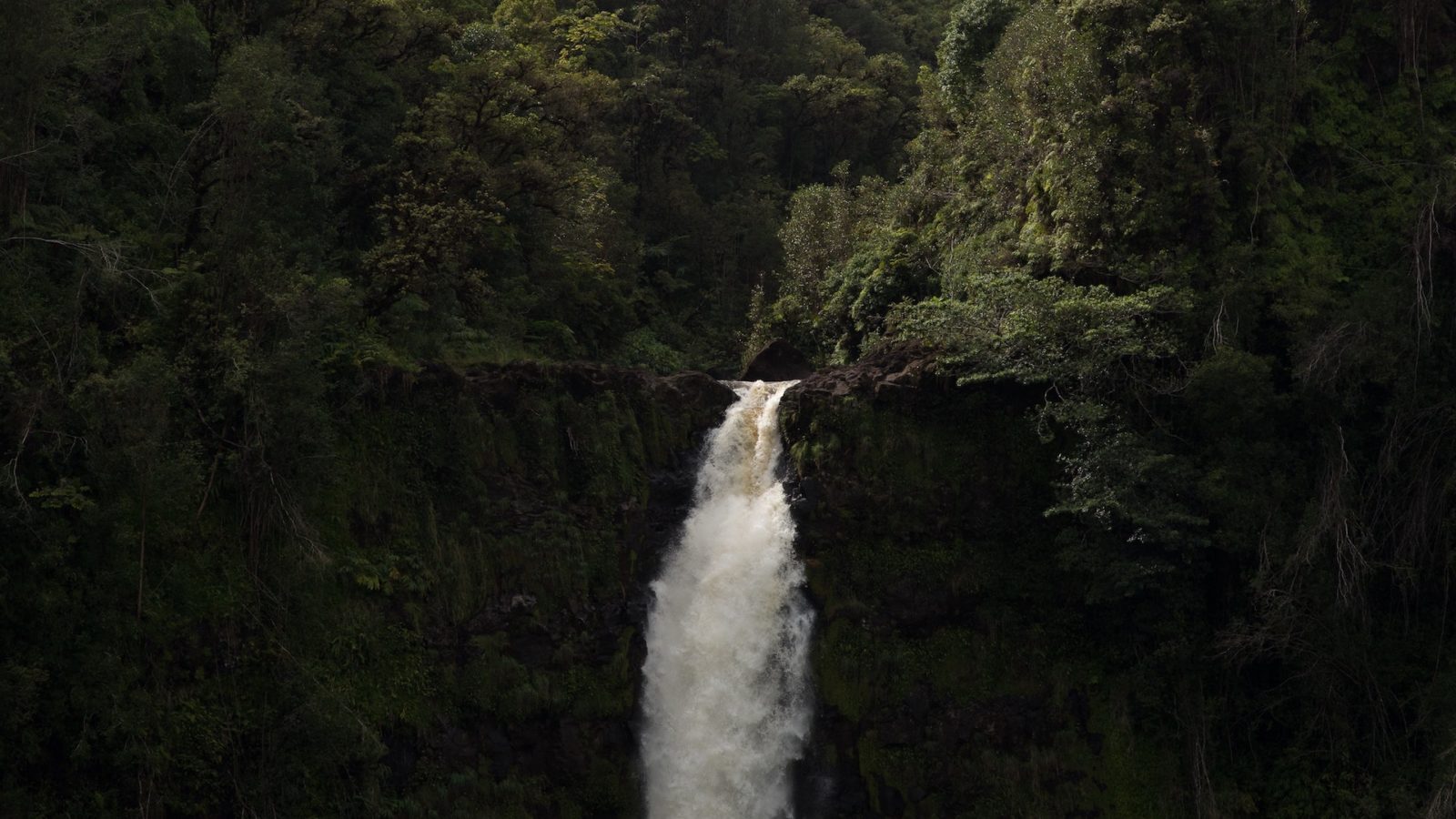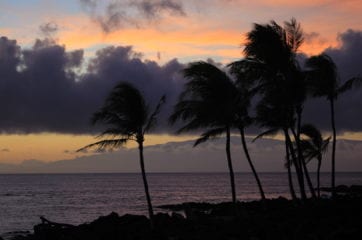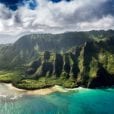Hawai‘i’s native forests have evolved for millennia to become an incredible array of biological diversity and abundance. There are close to 1,400 plants native to Hawai‘i, with around 90 percent of them found nowhere else in the world. Healthy, native forests sequester carbon and allow freshwater aquifers to recharge with rainfall, furthering the islands’s biodiversity.
Hawaiʻi’s native organisms are sensitive to change, and many species have declined with the anthropogenic clearing of land for agriculture and introduction of plants and animals from other regions. These threats have led to the loss of endemic organisms and their habitats, and consequently a decline in freshwater quality and abundance.
The worst damage occurred during the 19th century, when cattle and other introduced livestock multiplied unchecked throughout Hawai‘i, destroying hundreds of thousands of acres of forest. Government and industry leaders, acknowledging the relationship between the native forests and water quality, realized that if the wreckage continued there would be no water for growing sugarcane — Hawai‘i’s emerging cash crop. In response, Hawai‘i’s forest reserve system was created, introducing a new era of public-private investment in forest restoration.
Today, volunteers — along with hundreds of state employees, dozens of environmental groups, and an army of local hunters — are still working hard to restore Hawai‘i’s native biota. The restoration efforts involve coordinating a diverse group of stakeholders that don’t always see eye-to-eye, millions of dollars in taxpayer-funded fencing, and trips to remote areas of the island chain to remove invasive plants. The goal isn’t just to save native species — it is also to protect Hawai‘i’s drinking water, which is essential for life on the islands.
Early Degradation of Hawaiian Forests
The history of forest management in Hawai‘i began with humans voyaging from the Marquesas, 2,500 miles away, around the fourth century A.D. They found an archipelago of islands rich in forest cover and full of lush windward valleys. These early settlers brought dogs, chickens, and pigs for food, as well as vegetables such as breadfruit, sugar cane, taro, and sweet potato. They used fire to clear forests on lower slopes to plant crops, and constructed fishponds and taro patches in fertile valleys. Species declined from habitat destruction, hunting, and predation by introduced dogs; the lowlands became the wao kanaka, the realm of people, and agriculture and settlements replaced the endemic landscape.
Despite lower agricultural changes, “the early Hawaiians took care to protect the upland forests, which they viewed as wao akua, or the realm of the gods.” The ahupua‘a system of water and land management, under which land was managed from the highest to lowest elevation, protected the upland water sources that sustained human life in the lowlands. Hawaiians established a sustainable management system in which no one took more from the land or sea than was needed.
Between 1100 and 1650, rapid population growth led to accelerated clearing of lowland forests and the implementation of large-scale irrigation systems and fishponds, which put increased pressure on the land. By the time Captain Cook arrived in the Hawaiian Islands in 1778, a majority of the original lowland forest had been substantially altered by more than 1,000 years of intensive agriculture.
Following European and American conquest, environmental destruction accelerated and spread up into the mountains. Millions of trees were harvested from the forests for sandalwood and then exported to China. Land management principles that had been developed and maintained for hundreds of years over the previous millennium were replaced with an extraction-focused approach, disregarding the long-term health of watersheds and complex social systems. The damage that harvesting sandalwood caused, however, was minor compared to the damage caused by livestock brought by westerners.
Furthermore, as shipping increased, demands for firewood and grazing land continued to degrade upland forests. Trading ships brought non-native birds and mosquitoes, introducing a key vector of avian malaria and pox to Hawai‘i’s native birds, which were soon eliminated from the warm, moist lowlands of every island. Deforestation had essentially destroyed the regional watershed on O‘ahu and concerns about Honolulu’s future water supply were beginning to arise.
Hawaiian Reforestation Origins
As sugar became the economic driver in Hawai‘i, the influence of sugarcane planters in local government increased. In 1903, with the support of the Hawaiian Sugar Planters’ Association, Act 44 was passed, calling for a division of forestry with authority to establish forest reserves . The early part of the twentieth century in Hawai‘i was marked by a massive reforestation effort, and a quarter of Hawaiian forests were placed in the forest reserve system. The first decade saw the establishment of 37 forest reserves comprising nearly 800,000 acres of state and private land, with nearly two million trees planted annually in the forest reserves. Unfortunately, most of the trees were invasive, non-native species such as eucalyptus and ironwood. While these introduced plants have prevented disaster, they have crowded out many native species of the Hawaiian forest ecosystem.
By World War II, the forest reserve system included 1.2 million acres, which is more than a quarter of the islands’ entire landmass. Growing concern about Hawai‘i’s unique natural ecosystems led to the creation of a statewide Natural Area Reserve System in 1970 and the passage of monumental endangered species legislation in the 1980s and 1990s. The major threat to Hawaiian forests is no longer logging or cattle ranching, but invasive animals and plants. Half of the islands’ endemic forests are already gone, and with them many of their native plants and animals. Almost three-quarters of the U.S.’s documented bird and plant extinctions are from Hawai‘i.
Current Efforts to Remove Invasive Species
For the past decade, volunteers have been working with the state Department of Land and Natural Resources (DLNR) to assist in the eradication of invasive plants from the nearly 2.2 million acres of protected forests across the island chain. A key species that these eradication teams focus on is the mule’s foot fern. In April of 2020, a volunteer looked through satellite images and identified the GPS coordinates of mule’s foot ferns on O‘ahu. A specialized team of volunteers has spent the past few months killing as many of these invasive plants as possible.
One of these volunteers is Serene Smalley, who has been removing non-native plants for the past six years.
“I can definitely see progress,” Smalley says. “It’s very, very rewarding.” The rewarding part is not the removal of invasive species — it is seeing native trees and bushes begin to return and flourish once again.
Two important native species are the koa tree and the ‘ohi‘a tree. Koa trees are tall and grow on the highest ridges, absorbing water from passing clouds and helping to trigger rainfall. Rain lands on shorter ‘ohi‘a trees, whose contours and thick bark are excellent at collecting water and directing it slowly into the ground. When an ‘ohi‘a tree dies, its place is often taken by the invasive strawberry guava, which has smooth, shiny bark and grows rapidly. When it rains, water runs off the bark of strawberry guava trees and onto the ground, negatively impacting nearby plants by leading to erosion and oversaturation.
The ‘ohi‘a is currently being threatened by a fungus called “rapid ‘ohi‘a death” that spreads through the air and prevents ‘ohi‘a from being able to absorb water.
“The big concern with rapid ‘ohi‘a death is that it could wipe out the building blocks of our watersheds,” said Katie Ersbak, a watershed partnerships planner with the state Department of Land and Natural Resources.
Rising sea levels will make some freshwater aquifers, which supply more than 90% of Hawaii’s fresh drinking water, turn brackish — meaning a mix of fresh and saltwater. In 2011, the state began to designate priority watersheds for conservation in an attempt to restore the at-risk aquifers. The conservation effort was named “The Rain Follows the Forest,” and the goal was to double the amount of protected watershed area in 10 years.
Five years into the initiative, a report to the Legislature showed the project had removed invasive species and built fences to protect about 133,000 acres of priority watershed across the state. “The Rain Follows the Forest” was replaced in 2015 by Governor David Ige’s goal to protect 30% of the state’s priority watersheds by the year 2030. With 10 years left to meet the goal, 55% of the noted watersheds are under high-level protection.
Possible Solutions Moving Forward
Despite Hawai‘i’s forest resources and a U.S. Forest Service presence, it remains one of the few states in the U.S. without a national forest. Existing conservation easements have the potential to form the basis for a national forest in Hawai‘i.
Several large landowners who have historically managed forest lands for grazing and ranching are currently interested in selling land. The combination of reduced land prices and a sympathetic private sector presents an opportunity for the U.S. Forest Service to purchase and protect vital regions of forest. An example of this partnership concept can be seen at Kona Hema, where 8,000 acres are owned by The Nature Conservancy (TNC) under Forest Legacy conservation easements.
U.S. Representatives Ed Case and Tulsi Gabbard recently introduced legislation in the U.S. House to explore the establishment of Hawai‘i’s first national forest.
“Hawai‘i’s forests are critical parts of our island ecosystems, home to the oldest living ancestors of this place — the flora and fauna that have so much to teach us about how to live sustainably,” said Gabbard. “Our forests protect us from runoff, recharge our aquifers, provide habitat for native species, and connect us spiritually to this ‘aina. We must explore every avenue to protect them.”
The lawmakers continued: “Our Hawai‘i National Forest Study Act would identify parcels of land that could later be incorporated into a national forest that would fulfill the National Forest System’s mission. It would also help inventory how best to conserve and expand Hawai‘i’s native koa, ‘ohi‘a and sandalwood forests. This [national forest] designation would also assist with federal resources for management and protection.”
Not everyone agrees with the legislators, however. Many Hawaiian locals loathe the idea of the federal government gaining control over any Hawaiian state land. O‘ahu resident Alex says,
“Taking forests to make a National Forest and giving control to the federal government would entail a lot of restrictions that may affect many Hawai‘i families for generations to come. This is nothing but another United States land grab. Please think of the people and allow them to be heard.”
While the means to achieving restored and thriving forested ecosystems remains shrouded in controversy and complications, the end goal is clear — a future where Hawaiian forests are full of native species and an abundance of clean rainfall.









